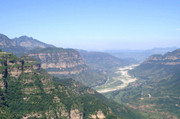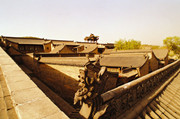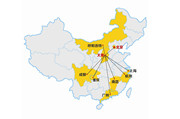Date with destiny
By Yu Fei ( China Daily )
Updated: 2009-12-07

Just before dawn in a quiet village in North China, a short-waisted man hurries with a bundle of poles toward a clump of weeds to wait for sunrise. He busily makes measurements and takes photos. He wants to prove that ancient astronomers once stood at the same place 4,100 years ago to determine the changing of sea
sons, by observing the sunrise and discerning the best times for sowing and harvesting.
A researcher with the Institute of Archaeology under the Chinese Academy of Social Sciences (CASS), He Nu, 46, is head of the excavation team at the Taosi relic site in Xiangfen county, Shanxi province.
Unlike his archaeological forebears, who carried their bedclothes, shovels and brushes to excavation sites, He is equipped with a four-wheel-drive vehicle, laptop, digital camera and mobile phone.

Influenced by Western archaeological ideas, He thinks farther and wider, to find a relevance to today in the remains of the past. Raising his eyes from the ruins below the weeds to the sun, He discovered what is believed to be the world's oldest observatory.
Chinese archaeologists launched a project in 2001 to seek the origins of their 5,000-year-old civilization. Taosi is one of the most important sites in this project. Much evidence has been found to indicate the Taosi site might have been the capital of the legendary Yao and Shun period, dating back more than 4,100 years.
In Chinese mythology, Yao and Shun were two sage emperors living on the middle reaches of the Yellow River. Many Confucian histories praised the two rulers as models of morality and benevolence, but skeptics in the early 20th Century challenged their existence.
"If you want to know where China is going, you have to know where it came from. The excavation work at Taosi will tell us where China came from, and whether Yao and Shun really existed," says He.
In his search for evidence of the undocumented era at Taosi, He found the ruins of a mysterious semi-circular building in 2003. After excavations, He found indications that 13 stone pillars were originally erected at the site, forming 12 gaps between them.
"It reminded me of Stonehenge in Britain. Ancient Chinese believed the sky was round, and the earth was square. All buildings related to the sky were built in the shape of circles. So we suspected the site might be related to astronomical observation," He says.
If it proves to be an observatory, it would be of great importance. The Confucian history, Shangshu, says the first official act of Emperor Yao was to observe the sky and improve the calendar.
In ancient times, life revolved around agriculture. A leader with an accurate astronomical calendar could reliably direct agricultural production, and the people would thrive, giving the leader supreme power.
Could the Emperor Yao have once stood in that place to observe the heavens?
He and his colleagues have attempted to recreate ancient observation techniques at the site since 2003. He plants the poles where the stone columns once stood and watches the gaps. If he can see the sun rise above the hills through the gaps according to the seasonal divisions of the traditional Chinese calendar, he will prove his theory that this place was an observatory.
His observations from December 2003 to April 2004 seemed to be going well, but when he took them to astronomers, they pointed out that he had wrongly used three observation points. They said there should only be one.
"The distance between the three points is less than 30 cm. Based on the lunar calendar, our observations on the winter solstice (around Dec 22), "major cold" (around Jan 20, indicating the coldest time of the year) and "grain rain" (around April 20, a time of increased rainfall which is good for crops) were very accurate. And the observation on the spring equinox (around March 20) was only one day later. How could that be wrong?" He argued with the astronomers.
"But I gave up, because I thought the astronomers were reasonable. I should respect science. That invalidated half a year's work. I was so distressed."




